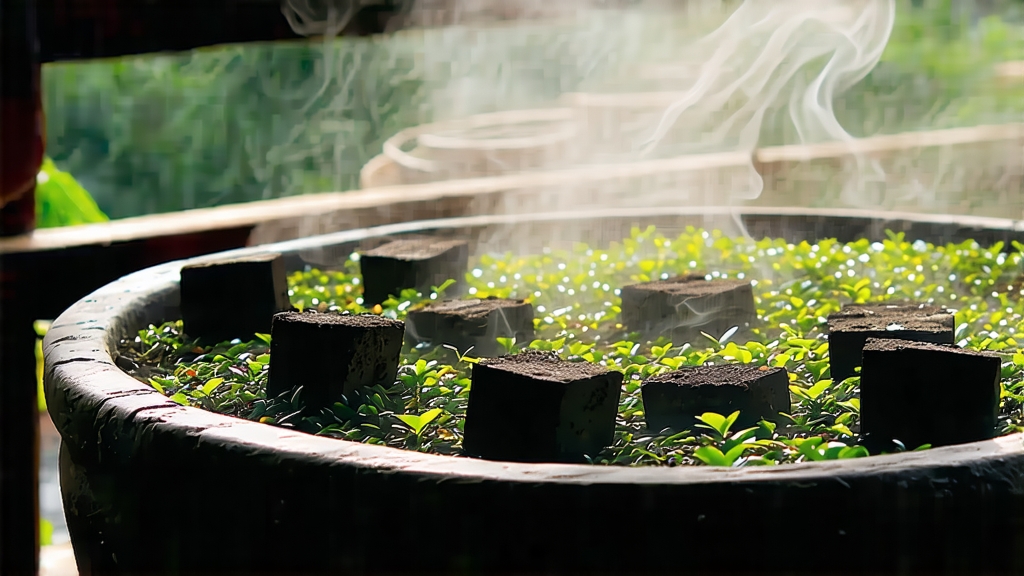
Tucked away in the humid, karst-pitted mountains of southern Guangxi, Liu Bao tea has spent four centuries quietly perfecting the art of microbial alchemy. To most outsiders “dark tea” begins and ends with Yunnan’s Pu-erh, yet Liu Bao is the older, subtler sibling—fermented, pressed, and then left to breathe inside tall bamboo baskets until its leaves smell of wet earth, dried longan, and the first drops of summer rain on terracotta. What follows is a complete journey through that leaf: its birth during Ming-dynasty border trade, the cascade of leaf grades still used today, the craft that turns green pickings into midnight velvet, and the gentle brewing rituals that coax velvet into song.
-
From Frontier Currency to Tea-Room Secret
In 1585 the imperial court of the Wan-li Emperor, desperate for war horses, opened the “Tea-Horse Exchange” along the southwestern frontier. Caravans leaving Guangxi’s Wuzhou prefecture carried two commodities: rice and a sturdy, sun-dried tea that travelled well and improved with the sweat of porters and the steam of jungle nights. Locals already called it Liu Bao—literally “Six Forts,” after the six stockades that once guarded the mountain pass. By the Qing dynasty the tea had reached Hong Kong and Malaya where tin-mine coolies drank it to ward off malaria and damp; in the 1970s it followed Cantonese migrants to Kuala Lumpur’s kopitiams, where it is still steeped in clay kettles and served with kaya toast. Only in the last decade has Liu Bao turned homeward, captivating a new generation of Chinese tea lovers who prize its deep, reassuring sweetness and its low caffeine lullaby. -
One Mountain, Many Leaf Styles
Liu Bao is not a single recipe but a family of grades governed by leaf age, pluck standard, and finishing technique. The traditional hierarchy begins with “Special Flag” (te ji), a bud-and-two-leaf pluck that retains downy tips even after piling; moves through Grade 1 to Grade 4, each successively larger and woodier; and ends with “Tea Stalk” (cha geng), the fibrous stems once shipped to Southeast Asia for boiling into medicinal soups. Modern micro-lots add wild-arbor leaves picked from feral trees that germinated during the Great Leap Forward when terraced farms were briefly abandoned; these leaves carry camphor and wild orchid notes impossible to cultivate. Finally there is “Lao Cha Tou,” the nuggets that congeal at the bottom of the fermentation pile—dark, sticky, and so dense they can be steeped a dozen times without unraveling. -
Craft: Where Chemistry Meets Bamboo
The journey from fresh leaf to fragrant brick unfolds in six acts, each timed by nose and weather rather than clock.
Withering: Pickings are spread on bamboo trays under morning mountain fog for 3–5 hours, softening cell walls without sun damage.
Kill-Green: A 5-minute tumble in a 200 °C drum halts oxidation but leaves a turquoise core—critical for later microbial bloom.
Rolling: Light pressure bruises margins while keeping stems intact, creating channels for moisture to escape during piling.
Wet-Piling (wo dui): The signature step borrowed from 16th-century horse-caravan necessity. Leaves are sprayed with mountain spring water, heaped 70 cm high, and covered with jute sacks. Inside the stack a consortium of Aspergillus niger, Blastobotrys adeninivorans, and local Penicillium species raise the temperature to 55 °C within 36 hours. Every three days the pile is turned, aerated, and re-moistened; after 25–30 days the leaf has turned walnut brown and smells of damp bark and molasses.
Drying: Instead of high-heat baking, Liu Bao is sun-dried on raised bamboo racks for two full afternoons, locking in a residual 12 % moisture that invites slow aging.
Basket-Aging: The semi-dry leaf is packed into two-foot-tall cylindrical bamboo baskets lined with wild banana leaf. These baskets are stacked in humid caves or riverside warehouses where annual monsoons swell the air to 85 % humidity. Over years the tea absorbs the scent of banana leaf and the micro-flora of the cave, gradually mellowing astringency into date-sweet richness.
4